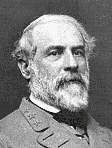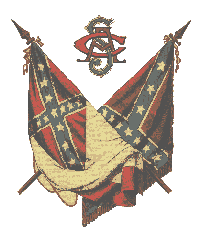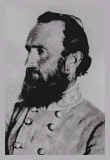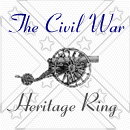


Army of Northern Virginia







Second Corps

|
|
 1865
1865
The 60th Georgia Infantry was formed in spring of 1862 as part of a new brigade of elite Georgia troops
being raised for service in Virginia. This brigade was created by Alexander R. Lawton, the Commander
of Georgia's Provisional Military, and was commonly called 'The Georgia Brigade'. General Lawton would personally lead this brigade until assigned temporary command of the entire Division after
General R. S. Ewell was wounded at Groveton. Three weeks later Lawton himself would be severely wounded at the battle of Sharpsburg and would linger near death for weeks while his family prayed over his broken form. Eight
months would pass before he was sufficiently recovered to return to duty. His replacement
as Brigade leader was John B. Gordon, one of the South's most capable commanders. A citizen soldier and true patriot, his daring, honor, and ingenuity would earn him a reputation as a fierce and cunning warrior, as well as a place at Lee's side in the last
days of a Free South. It is his name that historians most often attach to the Georgia Brigade, a testament to his leadership abilities and success in combat. After
his eventual promotion to Division (and ultimately Corps) Leader the Brigade was commanded by C.A. Evans, who would later
serve as commander of the United Confederate Veterans after the war. Evans, just as Gordon did,
would rise to Division command and would also serve through the last days until Appomattox. The men of the Georgia Brigade (also known as the Lawton/Gordon/Evans Brigade) would prove
themselves to be both the "flower of Georgia manhood" and the equal of any among the great
knights of The Cause. On many a battlefield their efforts would prove pivotal or decisive. At Gaines Mill they would receive instant recognition in their first battle by breaking through the federal line of Syke's Division. At Sharpsburg they would initially hold their ground in the famous cornfield before being pushed back in an attack by ten federal brigades. They would lead the counter-attack at Fredericksburg and drive Franklin back to the Rhappahannock. At Wilderness Tavern they would strike Sedgewick's Sixth Corps and roll up the entire federal right flank. At Spottsylvania their counter-attack would stop Hancock's breakthrough at the "muleshoe" or "bloody angle". They would lead the flank attack on Wallace at Monocacy, opening the door to Washington D.C. for Jubal Early. Their Brigade would suffer more combat losses than any other in Confederate service, with the single exception
of the combined Louisiana Brigades of Hays and Taylor (12 regiments). During the Georgian's first six month campaign in 1862
the Brigade suffered casualties of 2,270 men out of 3,500 present for duty in the six regiments. At Sharpsburg (Antietam) alone the Brigade suffered a casualty rate
of 49%. Southern Blood for Southern Freedom, and freely given.
The 60th Infantry Regiment was mustered into Confederate Service in the spring of 1862 after four companies were added to Stileís 4th Georgia Battalion. Colonel William Stiles had organized his original six company unit in the summer of 1861 at Dalton, Georgia with men recruited from the counties of Bartow, Dooly, Gilmer, Meriwether, Paulding, Troup and Whitfield. These men served on the coast at Hilton Head prior to the creation of the 60th, and were under fire from the federal fleet during the loss of Fort Walker. The soldiers in the four new companies came from the counties of Bartow, Dooly, Fannin, Gilmer, Walker, and Whitfield. Some already belonged to independent companies or disbanding squads, but most were new recruits.
In May of 1862, after completing their organization at Savannah, the 60th Infantry Regiment was ordered to Virginia. It's official assignment was to Lawtonís Brigade, Jacksonís old Division, Jackson's (2nd) Corps, Army of Northern Virginia under the command of General Robert E. Lee. The men of the 60th Georgia Infantry would then begin a career of military service that would repeatedly take them into the bloodiest fighting of the eastern theater. While under the command of the South's greatest Generals they would fight with heroic tenacity and vigor until stacking their arms for the last time on April 9, 1865. Under the legendary Stonewall Jackson they would fight at Gaines Mill, Malvern Hill, Bristoe Station, Groveton, 2nd Manassas, Chantilly, Sharpsburg, Shepardstown, Fredericksburg, and Chancellorsville. Richard Ewell would lead them through the smoke and fire of Gettysburg, the Wilderness, Spottsylvania and Cold Harbor. With Jubal Early they would march into the Shenandoah Valley and battle at Monocacy, poise to attack Washington D.C., and then engage the enemy at Winchester, Fisherís Hill, and Cedar Creek. The immortal John B. Gordon, their former Brigade and Division Commander, would lead the 60th and the rest of Second Corps through the fierce and stubborn contests of Hatcherís Run, the Petersburg trenches, the bloody assault on Fort Steadman, and Saylerís Creek. They would fight the last battles of the Appomattox Campaign in the rear guard of the Army of Northern Virginia, valiantly holding off the pursuing Federal hordes as General Lee made his desperate bid to join forces with The Army of Tennessee.
From the Seven Days' Battles to Appomattox
Courthouse, the men of the 60th Regiment gave their all and fought with the utmost conviction
and confidence to defend the South and her Great Cause, a last ditch effort to preserve the
governmental principles of the founding fathers. In the sacred pursuit to maintain the Original Principles
the regiment would perform its duties with a characteristic distinction and deservedly earn its place
in the hallowed annals of Confederate
History. Within these web-pages you will find the names of these men, and with many you will also
find the place and day on which they earned eternal glory. Salute them all, they fought with Lee.
Sorry for the Delay! The remaining rosters should be here very soon.
MUSTER ROLLS, MAPS, PHOTOGRAPHS, AND MORE !!!
General Robert E. Lee to Governor Stockdale of Texas

 confederate@starmail.com
confederate@starmail.com

 |
 |
 |
 |

 This Civil War Heritage Ring site is owned by
This Civil War Heritage Ring site is owned by Patrick Cromer. Enlist in the Civil War Heritage Ring! |
|---|
| [Skip Prev] [Prev] [Next] [Skip Next] [Random] [Next 5] [List Sites] |

 This Regiment's of
the Confederate Army site is owned by Pat Cromer .
This Regiment's of
the Confederate Army site is owned by Pat Cromer .
Want to join the Regiment's of the Confederate Army?
[Skip
Prev] [Prev] [Next
] [Skip Next] [Random]
[Next 5]
[List Sites]